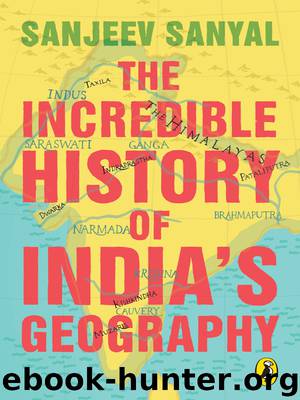The Incredible History of India's Geography by Sanjeev Sanyal

Author:Sanjeev Sanyal
Language: eng
Format: epub
ISBN: 9789351189329
Publisher: Penguin Books Ltd
Published: 2014-12-17T16:00:00+00:00
Although Babur had finally conquered this region, what he really wanted was Samarkhand. He did not think very highly of India. In his opinion, Hindustan ‘is a place of little charm. There is no beauty in its people, no graceful social intercourse, no poetic talent or understanding, no etiquette, nobility or manliness. The arts and crafts have no harmony or symmetry. There are no good horses, meat, grapes, melons, or other fruits. There is no ice, cold water, good food or bread in the markets.’ Then why did Babur invade India at all? He’s quite honest about it: ‘The one nice aspect of Hindustan is that it is a large country with lots of gold and money.’
Babur died less than five years after he came to India. After him came his son Humayun, who started the construction of the next Delhi—Dinpanah. Built just south of Feroze Shah Kotla, along the river Yamuna, it included a Citadel that we now know as Purana Qila (or Old Fort). As we have discussed, this is said to be the site of ancient Indraprastha but there is nothing to suggest that this is why Humayun chose this place. In addition to the Citadel, there was a fortified city. Not much has survived of Dinpanah except one of its impressive gates—the Lal Darwaza (Red Gate). You can see this massive structure across the road from Purana Qila and Delhi Zoo.
But Humayun did not complete either Dinpanah or Purana Qila. He was chased out by a group of Afghan rebels led by Sher Shah Suri. He escaped with his family to Persia and it was Sher Shah Suri who completed the construction of Purana Qila. Though he ruled for a short time, Sher Shah Suri introduced many vital changes. He reorganized tax collection, minted the first silver Rupiya (the earliest version of the modern Indian rupee) and revived the ancient city of Pataliputra (Patna). He also rebuilt the ancient Uttara Path highway from Punjab to Bengal. Known as Sadak-e-Azam (or Great Road), it became a major artery of the Mughal period. The British called it the Grand Trunk Road which, as we know, is now part of the Golden Quadrilateral.
Sher Shah Suri died in a gunpowder-related accident just after five years on the throne. Humayun came back and reoccupied Delhi. But it seemed as if Sher Shah Suri’s bad luck had followed him, too. On one fateful day, Humayun went to watch the rise of Venus from the roof of his library. On his way down the steep stairs, he tripped on his robe and died from the fall. Humayun’s library building is still there in Purana Qila. The stairway also exists but is not open to the public.
With humyaun’s death, thirteen-year-old Akbar became the new ruler. He is usually called the third Mughal Emperor but it was actually he who created the foundations of a stable empire. Apart from continuing with the changes introduced by Sher Shah Suri, he attempted to improve relationships with the Hindus living in his empire in the second half of his reign.
Download
This site does not store any files on its server. We only index and link to content provided by other sites. Please contact the content providers to delete copyright contents if any and email us, we'll remove relevant links or contents immediately.
| Historic | Information Systems |
| Regional |
Man-made Catastrophes and Risk Information Concealment by Dmitry Chernov & Didier Sornette(5956)
The Revenge of Geography: What the Map Tells Us About Coming Conflicts and the Battle Against Fate by Kaplan Robert D(4052)
Zero Waste Home by Bea Johnson(3805)
COSMOS by Carl Sagan(3589)
Good by S. Walden(3521)
In a Sunburned Country by Bill Bryson(3507)
The Fate of Rome: Climate, Disease, and the End of an Empire (The Princeton History of the Ancient World) by Kyle Harper(3032)
A Wilder Time by William E. Glassley(2835)
Camino Island by John Grisham(2778)
Organic Mushroom Farming and Mycoremediation by Tradd Cotter(2661)
The Ogre by Doug Scott(2657)
Human Dynamics Research in Smart and Connected Communities by Shih-Lung Shaw & Daniel Sui(2479)
Energy Myths and Realities by Vaclav Smil(2463)
The Traveler's Gift by Andy Andrews(2435)
9781803241661-PYTHON FOR ARCGIS PRO by Unknown(2343)
Inside the Middle East by Avi Melamed(2325)
Birds of New Guinea by Pratt Thane K.; Beehler Bruce M.; Anderton John C(2236)
A History of Warfare by John Keegan(2213)
And the Band Played On by Randy Shilts(2165)
